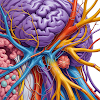Top 50 Questions about Everyday Science with Answers
 |
| Top 50 Questions about Everyday Science with Answers |
Q.No.01 Which is the first part of small intestine?
Ans. Duodenum (connects to the stomach).
Q.No.02 Which is the
second part of small intestine?
Ans. Jejunum.
Q.No.03 Which is the
third part of small intestine?
Ans. Ileum.
Q.No.04 Which part of
small intestine accomplishes a good deal of chemical digestion, as well as a
small amount of nutrient absorption?
Ans. Duodenum.
Q.No.05 What is the
primary function of the jejunum in small intestine?
Ans. To absorb sugars, amino acids, and fatty acids.
Q.No.06 What is the role
of ileum in digestion?
Ans. Absorbs bile acids, fluid, and vitamin B-12.
Q.No.07 What are the
permanent folds in the mucosa and sub-mucosa of the small intestine?
Ans. Plicae circulare.
Q.No.08 An endopeptidase
that breaks down dietary proteins reaching the stomach into amino acids is
called?
Ans. Pepsin.
Q.No.09 What is the most
common symptom of esophageal disease?
Ans. Heartburn.
Q.No.10 Which organ is
considered as chemical factory of human body?
Ans. Liver.
Q.No.11 What digestive
product does the liver produce?
Ans. Bile.
Q.No.12 The products of
the liver and pancreas participate in what type of digestion?
Ans. Mechanical and chemical, respectively.
Q.No.13 Which part of
digestive system helps in the absorption of water and some salts from the
undigested food materials?
Ans. Lage intestine.
Q.No.14 Water from
undigested food is absorbed mainly in the?
Ans. Large intestine.
Q.No.15 The digestive
system processes food into usable and unusable materials. The usable materials
are sent to the body’s cells as food. What happens to unusable materials?
Ans. It goes into the large intestine to await
disposal.
Q.No.16 Hydrochloric acid
triggers the release of enzymes such as _______ which are essential for the
digestion of protein?
Ans. Pepsin.
Q.No.17 “Gastric juice”
is a secretion of the glands present in________?
Ans. Stomach.
Q.No.18 Which hormone
stimulates the production of gastric juice in the stomach?
Ans. Gastrin.
Q.No.19 What part of the
digestive tract has 3 layers of smooth muscle in the muscularis externa?
Ans. Stomach.
Q.No.20 Name the layer in
the wall of the stomach that contains nerves and blood vessels?
Ans. Sub Mucosa.
Q.No.21 What is the role
of mucus secreted by the stomach?
Ans. Protects the lining of stomach from its own
secretions of hydrochloric.
Q.No.22 In human body,
the main digestion of protein being in which organ?
Ans. Stomach.
Q.No.23 What happens when
food reaches the stomach?
Ans. Juices mix with the food and stomach muscles
squeeze it.
Q.No.24 Spicy food,
coupled with anxiety, may lead to _______?
Ans. Indigestion.
Q.No.25 one of the
reasons why some people cough after eating a meal may be due to the improper
movement of _______?
Ans. Epiglottis.
Q.No.26 _______ is known
as a protein deficiency disorder?
Ans. Kwashiorkor.
Q.No.27 Doctors will
suggest _______ if person is suffering from high blood cholesterol.
Ans. Vegetable oil.
Q.No.28 Chymosin is also
known as ________?
Ans. Rennin.
Q.No.29 nyctalopia can
occur due to the deficiency of _______?
Ans. Vitamin A.
Q.No.30 pancreatic juice
is stimulated by the release of?
Ans. Secretin & cholecystokinin.
Q.No.31 Enterokinase
helps in the conversion of?
Ans. Trypsinogen into trypsin.
Q.No.32 The ________ is
the center of cardiovascular system?
Ans. Heart.
Q.No.33 What is the study
of heart called?
Ans. Cardiology.
Q.No.34 The heart is
enclosed in a membrane called ________?
Ans. Pericardium.
Q.No.35 The thickest
layer in the heart is?
Ans. Myocardium.
Q.No.36 The human heart
is located within the _________?
Ans. Thoracic Cavity.
Q.No.37 Thoracic cavity,
the second largest hollow space of the body. It is enclosed by the ________?
Ans. Ribs/Rib Cage.
Q.No.38 What is the
average weight of Human heart?
Ans. Around 250-350g.
Q.No.39 How many chambers
does the heart have?
Ans. Four.
Q.No.40 There are how
many kinds of blood vessels in human body?
Ans. Three types.
Q.No.41 What are the 3
types of blood vessels?
Ans. Arteries, Veins & Capillaries.
Q.No.42 The blood vessels
which convey blood away from heart called______?
Ans. Arteries.
Q.No.43 The blood vessels
that carry blood back to the heart are called________?
Ans. Veins.
Q.No.44 The vessels which
communicate blood from heart to various organs or other parts are called?
Ans. Capillaries.
Q.No.45 The blood vessels
that carry oxygenated blood?
Ans. Arteries (red).
Q.No.46 What vessels
carry deoxygenated blood away from the heart?
Ans. Pulmonary artery only.
Q.No.47 What is the main
function of the veins in the circulatory systems?
Ans. Carry blood back to the heart.
Q.No.48 Which type of
vein is responsible for carrying oxygenated blood back to the heart from the
lungs?
Ans. Pulmonary vein.
Q.No.49 Where oxygen and
nutrients are exchanged for carbon dioxide and wast?
Ans. Capillaries.
Q.No.50 Blood which heart
pumps to lungs is ________?
Ans. Deoxygenated blood.
Top 50 Questions about Everyday Science with Answers
GK Questions and Answers on Everyday Science
Everyday Science Quiz 50
Everyday Science General Knowledge Questions
Everyday Science Questions Answers-2
General Knowledge: General
Science
Top 50 Everyday Science MCQS for Competitive Exams |
Science Quiz Questions & Answers |Science Quiz



0 Comments